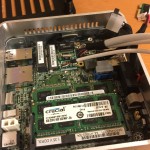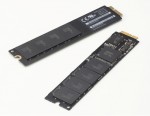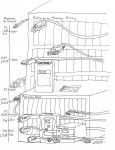After some frustration with stability and latency connecting my virtual pfSense router to my cable and DSL modems, I decided to switch to a physical box. I selected the Netgate RCC-VE 2440 as my hardware platform, since it’s the same box that pfSense themselves use as their OEM bundle. It also checks all the boxes with a dual-core Atom CPU, four Gigabit Ethernet ports, and low-power fanless design. Here’s my first impression and installation notes!
mSATA
Adding a Second Ethernet Port to an Intel NUC via Mini PCIe
As I mentioned in my previous post about Raspberry Pi power monitoring, I recently built a VMware vSphere “datacenter” from three Intel NUC mini PC’s. One limit of the NUC is that it has just one Ethernet port. But there’s a Mini PCIe slot inside the fourth-generation NUC that can be used to add a second Ethernet NIC!
Apple Brings PCIe SSD To The Masses In The New MacBook Air
Apple’s brand-new MacBook Air might not look much from the outside, but a revolution lurks under the hood: This is the first mainstream computer to eschew SATA in favor of PCIe SSD! Long heralded in workstations and servers, PCIe SSD brings massive potential for storage performance.
Toshiba Offers “Blade” SSDs (Like Apple’s MacBook Air)
More information about the unconventional SSD used in Apple’s new MacBook Air. As I discussed in my previous coverage of this new flash form factor, it resembles a PCI Express Mini Card but is much smaller. Toshiba has now proved my speculation that the device uses SATA signals rather than the PCI Express lane used by the similar AirPort card. We also know that the lauded performance of the device is due to its chips and controller rather than skipping SATA in favor of PCIe as some had speculated.
How Fast Is It? A Storage Infographic
How fast is a hard disk drive? How about the various flavors of SATA and Fibre Channel? Check out this handy Pack Rat infographic to answer the question, “how fast is it?”




